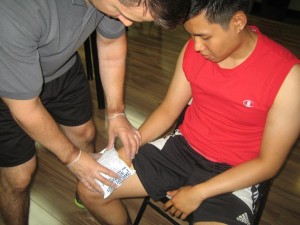A stingray is flat-bodied cartilaginous fish with plenty of barbed stingers found in the midway on the tail. They are usually found in coastal tropical and subtropical marine waters and make it possible for them to come in direct contact with humans. These animals are not aggressive, but use the stinger in self-defense when they are accidentally stepped on and secrete venom into the wound of the victim.
The stingray releases a poisonous chemical into the skin through their spine and affects human body. Not all stingrays have poisons in their spines.
Symptoms of stingray sting
- Severe pain which can last for 2 days
- Swelling around the wound
- Bleeding
- Dizziness or lightheadedness
- Muscle cramps or weakness
- Irregular pulse
- Seizures
- Redness or blue coloring around the wound
- Low blood pressure

Control any bleeding by applying direct pressure at the affected area or slightly above the area using one finger for a few minutes until bleeding subsides. - Headache
- Palpitations
- Fainting
- Difficulty breathing
- Fainting
- Nausea/vomiting/diarrhea
Factors with a high risk for stingray stings includes sea divers, picking up stingrays with bare hands, walking on the beach or in shallow water and handling dead or alive species of stingray.
Treatment
- While still in water, wash the wound using the sea water to remove remains of the spine and tissue. Get out of the water.
- Using the tweezers gently remove pieces of spine from the affected area. Avoid removing the spines from the chest, neck and abdomen. Dry the affected area using a towel and prevent further injuries.
- Control any bleeding by applying direct pressure at the affected area or slightly above the area using one finger for a few minutes until bleeding subsides.
- Soak the affected area in hot water to lessen the pain by destroying the venom protein complex. Soak the wound for at least 30-90 minutes with temperature of 45 C or 113 F, or until the pain is reduced. Avoid making the water too hot to prevent burning the skin and worsen the condition.
- Keep the area clean. Wash the affected with soap and water. Pat dries the area and then applies the prescribed antibiotic ointment every day and avoid covering the wound.
- If the area becomes tender, red, itchy, sore and starts to swell and develops a cloudy discharge, take the prescribed antibiotics to lessen the pain and the inflammation. Another alternative is draining the abscess.
- If the sting is severe, give CPR or cardiopulmonary resuscitation if there is breathing difficulties. Stabilize the blood pressure of the affected person. Prescribed pain medications such as steroids to lessen the pain and the inflammation.
Tips
- Avoid any attempt of touching or handling marine animals unnecessarily
- Keep watch of warning of lifeguards or health officials at the beach.
- Avoid touching dead stingray, they can still sting.
- Wear protective clothing and footwear when planning to swim or walking and wading in shallow waters.
- When removing stingray stinger from the body wear protective cover for the hand such as hand gloves.
Disclaimer / More Information
The material posted on this page on a stingray sting is for learning purposes only. Learn to manage the injury by taking a first aid and CPR class with one of our training providers.
